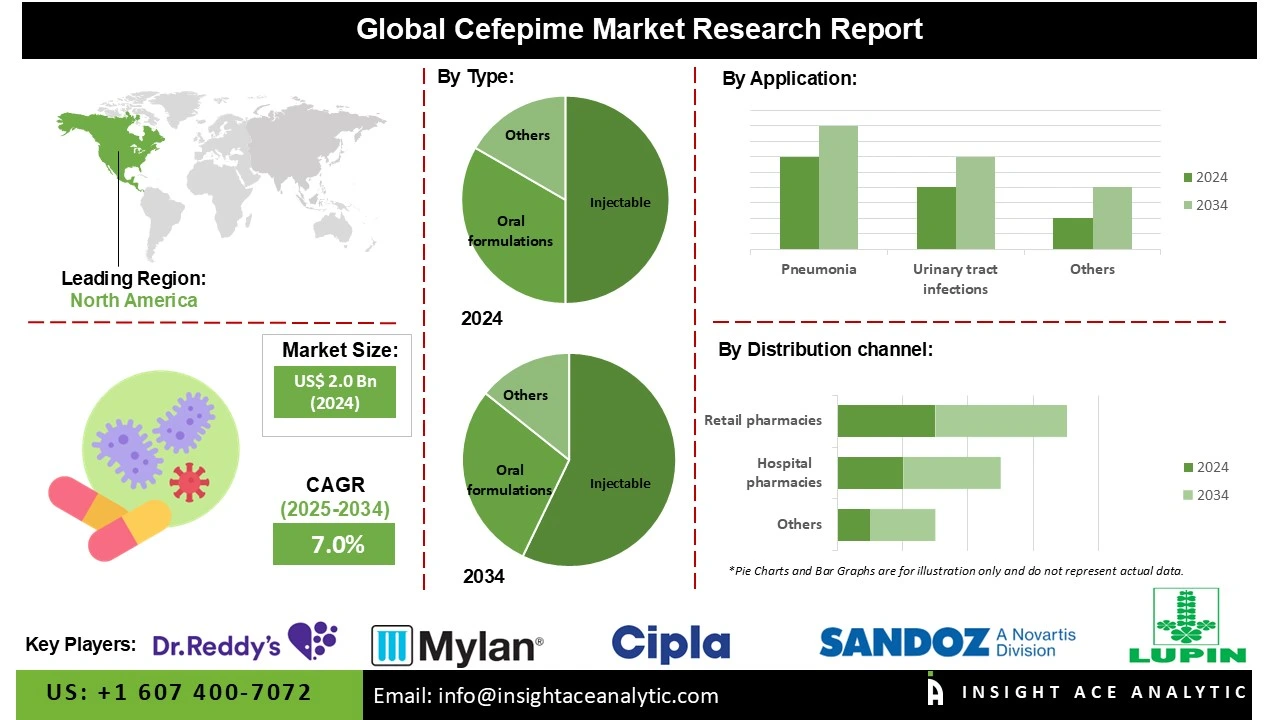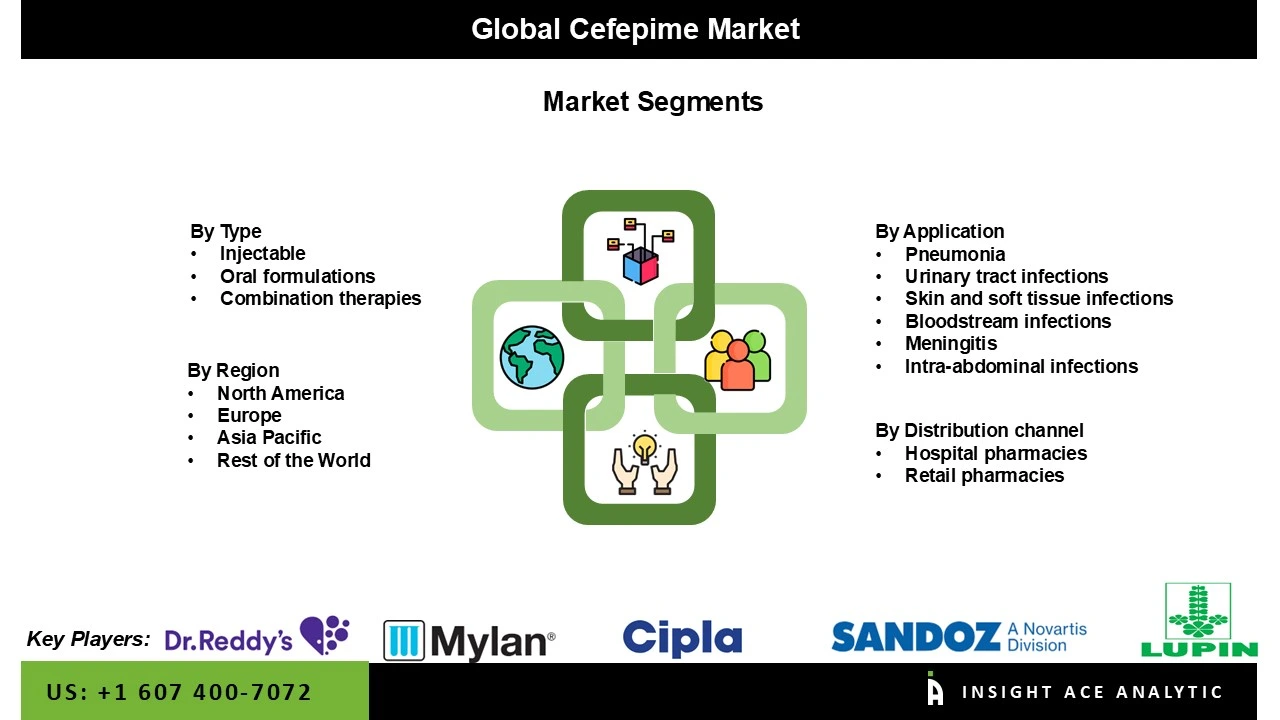Global Cefepime Market is valued at US$ 2.0 Bn in 2024 and it is expected to reach US$ 3.86 Bn by 2034, with a CAGR of 7.0% during the forecast period of 2025-2034.
Cefepime, a fourth-generation cephalosporin antibiotic, serves as a fundamental agent in the treatment of severe bacterial infections within hospital environments. Its mechanism of action entails the inhibition of bacterial cell wall synthesis, resulting in the elimination of susceptible organisms.

A key feature of cefepime is its broad spectrum of activity, which encompasses both Gram-positive and Gram-negative bacteria, including Pseudomonas aeruginosa and many strains resistant to earlier-generation cephalosporins. It is a first-line agent for treating hospital-acquired pneumonia, complicated urinary tract infections, empiric therapy for febrile neutropenia, and other severe intra-abdominal and skin infections.
The sustained clinical demand for cefepime is driven by several interconnected factors. The global rise in antimicrobial resistance necessitates the use of potent, broad-spectrum agents like cefepime for empiric coverage. Furthermore, an aging population and a growing number of surgical procedures, which require prophylactic and therapeutic antibiotics, underpin its consistent use. The expansion of healthcare infrastructure, mainly in emerging economies, is increasing access to advanced injectable antibiotics. In response to these demands, the pharmaceutical industry continues to develop new formulations, such as ready-to-mix products, to enhance safety, convenience, and integration into hospital protocols. These factors collectively ensure cefepime's continued critical role in the antimicrobial arsenal.
Some of the Key Players in Cefepime Market:
The Cefepime market is segmented by Type, Application, and Distribution Channel. By Type, the market is segmented into Oral Formulations, injectables, and Combination Therapies. By Application, the market is segmented into Pneumonia, Meningitis, Urinary Tract Infections, Bloodstream Infections, Skin and Soft Tissue Infections, and Intra-abdominal Infections. The Distribution Channel segment comprises Hospital Pharmacies and Retail Pharmacies.
In 2024, the injectable formulation segment continues to dominate the cefepime market, a position reinforced by the drug's primary use in treating severe, hospital-managed infections. These intravenous solutions are commercially available in standardized concentrations, most commonly 500 mg/100 mL and 1 g/100 mL, to accommodate diverse dosing requirements based on infection severity and patient renal function. The solutions are characterized as sterile, non-pyrogenic, and transparent, ranging from colorless to a pale yellow liquid.
The sustained growth of this segment is primarily driven by the escalating global prevalence of serious bacterial infections, particularly those caused by multidrug-resistant organisms, where cefepime's broad-spectrum coverage remains critical. Market innovation is focusing on enhancing administration convenience and safety through advanced delivery systems, such as prefilled syringes and ready-to-mix formulations, which reduce preparation errors and improve workflow in clinical settings. Concurrently, ongoing pharmaceutical R&D aimed at optimizing injectable therapies to counter evolving antibiotic resistance provides further momentum for the segment's expansion.
The pneumonia category accounted for the largest share of the cefepime market in 2024. Growing pneumonia incidence and hospitalizations, particularly among older persons and other high-risk categories, have increased the number of patients requiring empiric and broad-spectrum IV therapy, which is driving higher demand for Cefepime within the pneumonia category. Additionally, as hospital-acquired and ventilator-associated pneumonia (HAP/VAP) and intensive care unit (ICU) admissions have increased, doctors have been forced to utilize agents with strong Gram-negative coverage, such as Cefepime, which is often used in empiric regimens advised by inpatient pneumonia guidelines.
In 2024, North America is projected to maintain its dominant position in the global cefepime market. This leadership is anchored by a confluence of key factors: a high concentration of leading pharmaceutical manufacturers, advanced and widely accessible healthcare infrastructure, and a significant clinical burden of bacterial infections. The region's stringent focus on infection control protocols and its role as a primary hub for medical innovation sustain a consistent demand for broad-spectrum antibiotics like cefepime. Furthermore, substantial and ongoing investment in biomedical research and development within the region is expected to solidify its market leadership for the foreseeable future.
Conversely, the Asia-Pacific region is forecast to experience the most rapid growth in the cefepime market during the projection period. This accelerated expansion is driven by powerful demographic and structural trends, including rising healthcare awareness, expanding population coverage, and improving access to advanced medical services. Major economies, notably China and India, are making significant investments in modernizing their hospital infrastructure, which directly facilitates the adoption of sophisticated antibiotics. This growth is further amplified by proactive government health initiatives aimed at curbing infectious diseases and streamlining regulatory pathways for essential medicines.
Chapter 1. Methodology and Scope
1.1. Research Methodology
1.2. Research Scope & Assumptions
Chapter 2. Executive Summary
Chapter 3. Global Cefepime Market Snapshot
Chapter 4. Global Cefepime Market Variables, Trends & Scope
4.1. Market Segmentation & Scope
4.2. Drivers
4.3. Challenges
4.4. Trends
4.5. Investment and Funding Analysis
4.6. Porter's Five Forces Analysis
4.7. Incremental Opportunity Analysis (US$ MN), 2025-2034
4.8. Competitive Landscape & Market Share Analysis, By Key Player (2024)
4.9. Use/impact of AI on Cefepime Market Industry Trends
4.10. Global Cefepime Market Penetration & Growth Prospect Mapping (US$ Mn), 2024-2034
Chapter 5. Cefepime Market Segmentation 1: By Type, Estimates & Trend Analysis
5.1. Market Share by Type, 2024 & 2034
5.2. Market Size Revenue (US$ Million) & Forecasts and Trend Analyses, 2021 to 2034 for the following Type:
5.2.1. Injectable
5.2.2. Oral formulations
5.2.3. Combination therapies
Chapter 6. Cefepime Market Segmentation 2: By Application, Estimates & Trend Analysis
6.1. Market Share by Application, 2024 & 2034
6.2. Market Size Revenue (US$ Million) & Forecasts and Trend Analyses, 2021 to 2034 for the following Application:
6.2.1. Pneumonia
6.2.2. Urinary tract infections
6.2.3. Skin and soft tissue infections
6.2.4. Bloodstream infections
6.2.5. Meningitis
6.2.6. Intra-abdominal infections
Chapter 7. Cefepime Market Segmentation 3: By Distribution channel, Estimates & Trend Analysis
7.1. Market Share by Distribution channel, 2024 & 2034
7.2. Market Size Revenue (US$ Million) & Forecasts and Trend Analyses, 2021 to 2034 for the following Distribution channel:
7.2.1. Hospital pharmacies
7.2.2. Retail pharmacies
Chapter 8. Cefepime Market Segmentation 4: Regional Estimates & Trend Analysis
8.1. Global Cefepime Market, Regional Snapshot 2024 & 2034
8.2. North America
8.2.1. North America Cefepime Market Revenue (US$ Million) Estimates and Forecasts by Country, 2021-2034
8.2.1.1. US
8.2.1.2. Canada
8.2.2. North America Cefepime Market Revenue (US$ Million) Estimates and Forecasts by Type, 2021-2034
8.2.3. North America High-Altitude Oxygen Simulation Market Revenue (US$ Million) Estimates and Forecasts by Application, 2021-2034
8.2.4. North America Cefepime Market Revenue (US$ Million) Estimates and Forecasts by Distribution channel, 2021-2034
8.3. Europe
8.3.1. Europe Cefepime Market Revenue (US$ Million) Estimates and Forecasts by Country, 2021-2034
8.3.1.1. Germany
8.3.1.2. U.K.
8.3.1.3. France
8.3.1.4. Italy
8.3.1.5. Spain
8.3.1.6. Rest of Europe
8.3.2. Europe Cefepime Market Revenue (US$ Million) Estimates and Forecasts by Type, 2021-2034
8.3.3. Europe Cefepime Market Revenue (US$ Million) Estimates and Forecasts by Application, 2021-2034
8.3.4. Europe Cefepime Market Revenue (US$ Million) Estimates and Forecasts by Distribution channel, 2021-2034
8.4. Asia Pacific
8.4.1. Asia Pacific Cefepime Market Revenue (US$ Million) Estimates and Forecasts by Country, 2021-2034
8.4.1.1. India
8.4.1.2. China
8.4.1.3. Japan
8.4.1.4. Australia
8.4.1.5. South Korea
8.4.1.6. Hong Kong
8.4.1.7. Southeast Asia
8.4.1.8. Rest of Asia Pacific
8.4.2. Asia Pacific Cefepime Market Revenue (US$ Million) Estimates and Forecasts by Type, 2021-2034
8.4.3. Asia Pacific Cefepime Market Revenue (US$ Million) Estimates and Forecasts by Application, 2021-2034
8.4.4. Asia Pacific Cefepime Market Revenue (US$ Million) Estimates and Forecasts by Distribution channel, 2021-2034
8.5. Latin America
8.5.1. Latin America Cefepime Market Revenue (US$ Million) Estimates and Forecasts by Country, 2021-2034
8.5.1.1. Brazil
8.5.1.2. Mexico
8.5.1.3. Rest of Latin America
8.5.2. Latin America Cefepime Market Revenue (US$ Million) Estimates and Forecasts by Type, 2021-2034
8.5.3. Latin America Cefepime Market Revenue (US$ Million) Estimates and Forecasts by Application, 2021-2034
8.5.4. Latin America Cefepime Market Revenue (US$ Million) Estimates and Forecasts by Distribution channel, 2021-2034
8.6. Middle East & Africa
8.6.1. Middle East & Africa Wind Turbine Rotor Blade Market Revenue (US$ Million) Estimates and Forecasts by country, 2021-2034
8.6.1.1. GCC Countries
8.6.1.2. Israel
8.6.1.3. South Africa
8.6.1.4. Rest of Middle East and Africa
8.6.2. Middle East & Africa Cefepime Market Revenue (US$ Million) Estimates and Forecasts by Type, 2021-2034
8.6.3. Middle East & Africa Cefepime Market Revenue (US$ Million) Estimates and Forecasts by Application, 2021-2034
8.6.4. Middle East & Africa Cefepime Market Revenue (US$ Million) Estimates and Forecasts by Distribution channel, 2021-2034
Chapter 9. Competitive Landscape
9.1. Major Mergers and Acquisitions/Strategic Alliances
9.2. Company Profiles
9.2.1. Hetero Labs Limited (India)
9.2.1.1. Business Overview
9.2.1.2. Key Product /Service Overview
9.2.1.3. Financial Performance
9.2.1.4. Geographical Presence
9.2.1.5. Recent Developments with Business Strategy
9.2.2. Dr. Reddy's Laboratories (India)
9.2.3. Mylan Pharmaceuticals (USA)
9.2.4. Cipla Limited (India)
9.2.5. Lupin Pharmaceuticals (India)
9.2.6. Sandoz (Germany)
9.2.7. Aurobindo Pharma (India)
9.2.8. Teva Pharmaceuticals (Israel)
9.2.9. Zydus Cadila (India)
9.2.10. Sun Pharmaceutical Industries Ltd. (India)
9.2.11. AbbVie Inc. (USA)
9.2.12. Novartis AG (Switzerland)
9.2.13. Fresenius Kabi (Germany)
9.2.14. Bayer AG (Germany)
9.2.15. Eli Lilly and Company (USA)
9.2.16. Shanghai United Cell Biotechnology Co., Ltd. (China)
9.2.17. WuXi AppTec (USA)
9.2.18. BioRidge Pharma (China)
9.2.19. Hikma Pharmaceuticals PLC (UK)
9.2.20. Alkem Laboratories Ltd. (India)
Cefepime Market by Type-
· Oral Formulations
· Injectable
· Combination Therapies

Cefepime Market by Application -
· Pneumonia
· Meningitis
· Urinary Tract Infections
· Bloodstream Infections
· Skin and Soft Tissue Infections
· Intra-abdominal Infections
Cefepime Market by Distribution Channel-
· Hospital Pharmacies
· Retail Pharmacies
Cefepime Market by Region-
North America-
· The US
· Canada
Europe-
· Germany
· The UK
· France
· Italy
· Spain
· Rest of Europe
Asia-Pacific-
· China
· Japan
· India
· South Korea
· Southeast Asia
· Rest of Asia Pacific
Latin America-
· Brazil
· Argentina
· Mexico
· Rest of Latin America
Middle East & Africa-
· GCC Countries
· South Africa
· Rest of the Middle East and Africa
InsightAce Analytic follows a standard and comprehensive market research methodology focused on offering the most accurate and precise market insights. The methods followed for all our market research studies include three significant steps – primary research, secondary research, and data modeling and analysis - to derive the current market size and forecast it over the forecast period. In this study, these three steps were used iteratively to generate valid data points (minimum deviation), which were cross-validated through multiple approaches mentioned below in the data modeling section.
Through secondary research methods, information on the market under study, its peer, and the parent market was collected. This information was then entered into data models. The resulted data points and insights were then validated by primary participants.
Based on additional insights from these primary participants, more directional efforts were put into doing secondary research and optimize data models. This process was repeated till all data models used in the study produced similar results (with minimum deviation). This way, this iterative process was able to generate the most accurate market numbers and qualitative insights.

Secondary research
The secondary research sources that are typically mentioned to include, but are not limited to:
The paid sources for secondary research like Factiva, OneSource, Hoovers, and Statista
Primary Research:
Primary research involves telephonic interviews, e-mail interactions, as well as face-to-face interviews for each market, category, segment, and subsegment across geographies
The contributors who typically take part in such a course include, but are not limited to:
Data Modeling and Analysis:
In the iterative process (mentioned above), data models received inputs from primary as well as secondary sources. But analysts working on these models were the key. They used their extensive knowledge and experience about industry and topic to make changes and fine-tuning these models as per the product/service under study.
The standard data models used while studying this market were the top-down and bottom-up approaches and the company shares analysis model. However, other methods were also used along with these – which were specific to the industry and product/service under study.
To know more about the research methodology used for this study, kindly contact us/click here